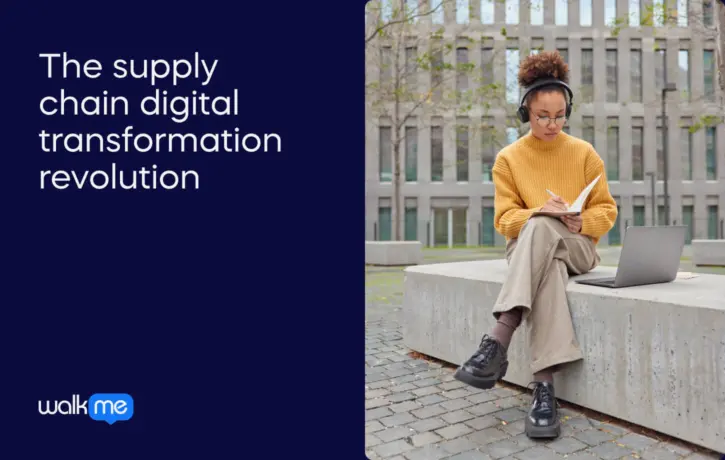How prepared is your supply chain for the digital technological changes your competitors are already researching and investing in?
If you find the challenge of initiating your supply chain digital transformation overwhelming, you are not alone. Bridging the gap between vision and reality remains a hurdle for many chief supply chain officers (CSCOs) who struggle to decide which digital tools are relevant and how to support staff to utilize them.
Translating their digital supply chain aspirations into actionable and communicated roadmaps proves challenging, with many currently having not defined or actively implemented such plans within a digital transformation.
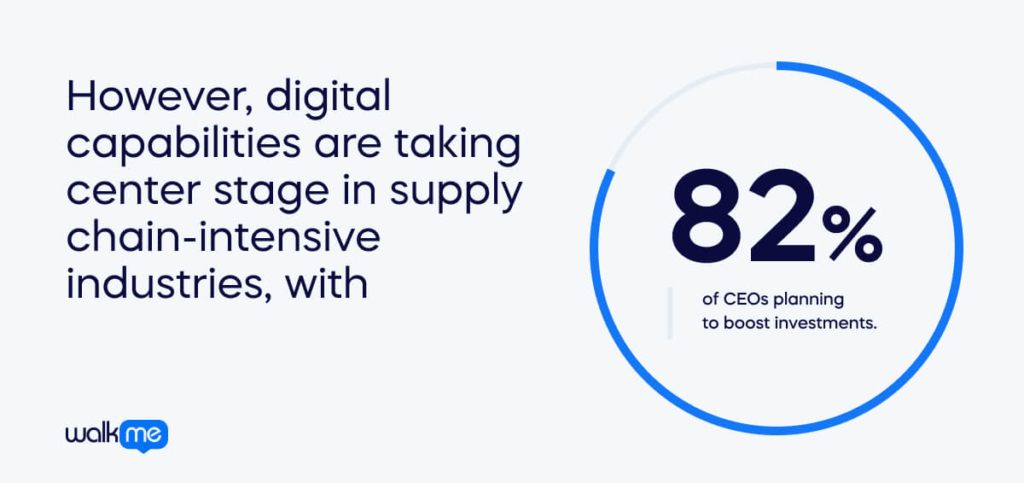
This article will explore the supply chain digital transformation revolution, covering what it is, how digitization impacts the supply chain, unfolding trends in this revolution, and the future of the digital supply chain.
What is supply chain digital transformation?
Supply chain digital transformation utilizes the transformative power of digital solutions to become more agile and competitive in the marketplace as part of their digital resilience. It involves accessing real-time supplier and consumer data, previously fragmented and siloed, to make it available through innovative technologies.
This process empowers organizations to make data-driven decisions, optimizing every facet of the supply chain.
Examples of supply chain digital transformation technologies include advanced analytics tools, Artificial intelligence (AI), and robotic process automation (RPA)
What does digitization do for the supply chain?
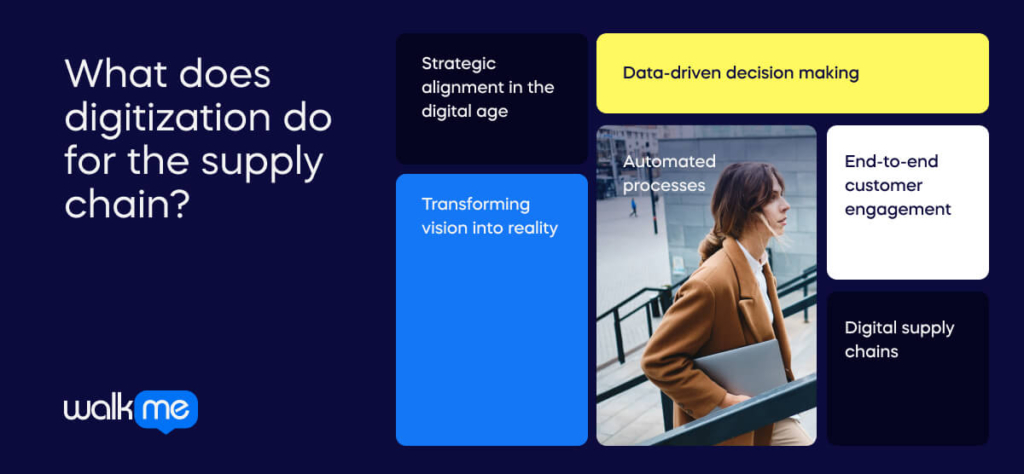
Effective supply chain transformation hinges on a clear and compelling vision in today’s dynamic business world.
Crucially, you must harmoniously align it with your overall business strategy, ensuring that the envisioned improvements extend beyond operational efficiency to create a strategic roadmap.
Navigating the future challenges that impact your company’s competitive landscape while simultaneously meeting your customers’ evolving expectations is crucial for sustained success.
Let’s explore further:
Strategic alignment in the digital age
While strategic alignment has always been paramount, the digital era demands a nuanced approach. Your strategic goals and supply chain vision must now factor in the unique pressures and opportunities an increasingly digitized economy presents.
Achieving this requires a proactive understanding of market trends, customer behavior shifts, and technological advancements.
Transforming vision into reality
Once established, you must translate the supply chain vision into concrete business and technical capabilities. These capabilities empower organizations to achieve the envisioned future state, including data-driven decision-making, automated processes, end-to-end customer engagement, and digital supply chains.
Data-driven decision making
Leverage machine learning algorithms to provide real-time recommendations for optimizing inventory, production, and delivery schedules in response to dynamic market conditions.
Automated processes
Implement robotic process automation (RPA) and other digital solutions like IoT monitoring to streamline routine tasks, freeing human resources for strategic analysis and problem-solving.
End-to-end customer engagement
Utilizing track-and-trace systems and intuitive customer portals enhances transparency, builds trust, and fosters stronger customer relationships throughout the supply chain journey.
By embracing a forward-looking vision and equipping it with the right capabilities, you can transform your supply chains into strategic assets, ensuring agility, resilience, and long-term success in the digital age.
Digital supply chains
These supply chains strengthen business models through market expansion and enhance collaboration via automated data integration with customers and suppliers, optimizing S&OP (sales and operations planning) decisions. However, this demands new talent. Supply chain leaders must bridge the gap between business needs and relevant digital applications.
Setting achievable performance goals completes the transformation vision. Companies can define goals across agility, service, capital, and cost metrics by assessing current performance, like improving shipment speed to reduce lost sales.
This alignment ensures digital initiatives deliver tangible results, propelling businesses towards a resilient and prosperous future.
6 ways the supply chain digital transformation revolution is happening

Whether you engage with it or not, the digital transformation revolution can improve your supply chain’s agility.
There are many benefits to engaging with digital transformation, such as enhanced connectivity. Embracing digital transformation enhances connectivity and fosters innovation, enabling your supply chain to adapt swiftly to evolving market dynamics.
Let’s explore further:
1. Enhanced connectivity
Digital tools are revolutionizing supply chain management by fostering unprecedented connectivity and visibility. Real-time product movement and location updates are now readily available, powered by GPS and Bluetooth tracking advancements. Additionally, sensor technology can detect disruptions or quality issues early, allowing for proactive intervention.
These data insights empower organizations to:
- Evaluate transportation performance and identify inefficiencies in distribution networks.
- Boost traceability and flexibility, enabling quicker issue identification and mitigation.
- Strengthen communication with suppliers, fostering collaboration and resilience across the entire supply chain.
2. More focus on customer demands
Technology now delivers vast data landscapes and transformative insights, surpassing traditional forecasting methods tied solely to historical trends. Past data, while valuable, can be ill-equipped for sudden market shifts, hindering response agility.
Digital advancements empower proactive demand anticipation. Sensor-equipped tools gather real-time environmental data, and intelligent analytics leverage advanced algorithms to generate replenishment recommendations. These predictive technologies harmonize historical data with current market conditions, yielding more reliable forecasting.
By embracing these innovations, supply chains can anticipate customer needs with unprecedented accuracy, ensuring optimized inventory levels and enhanced responsiveness to ever-evolving market dynamics.
3. Digital thread creation
The digital thread revolutionizes collaboration and responsiveness by unifying data throughout the supply chain. This interconnected web, spanning systems and users, fosters an unprecedented flow of information.
This enhanced visibility empowers organizations to navigate disruptions in manufacturing, distribution, or any product stage with agility and precision.
The more data woven into the digital thread, the more prepared your organization is to tackle unforeseen challenges. This integrated ecosystem, encompassing you, suppliers, and consumers, fosters closer collaboration, optimized efficiency, and stronger relationships.
The digital thread isn’t just a communication structure; it’s the fabric of a resilient and future-proof supply chain.
4. Improved collaboration
Imagine a supply chain as a crystal-clear globe: every stage, from raw materials to customer doorstep, illuminated and interconnected. Herein lies the power of the integrated supply chain, where seamless omnidirectional communication unveils new levels of visibility and data sharing.
Constant data streams pulse through this network, offering real-time insights into inventory levels, product availability, shipping statuses, and beyond.
With this holistic understanding, supply chain organizations can shed reactive mindsets and embrace future-focused approaches. Predictive analytics anticipate demand changes before they materialize, enabling proactive adjustments and optimized resource allocation.
The benefits of internal optimization include:
- Suppliers: Gaining early visibility into demand fluctuations allows them to adjust production schedules and avoid costly overstocking or understocking.
- Customers: Real-time tracking enhances transparency and trust, fostering stronger relationships and improved customer satisfaction.
End-to-end transparency doesn’t stop at individual data points. The integrated supply chain facilitates company-wide data synthesis, enabling deeper analysis than ever before. Silos crumble as information seamlessly flows across all business systems, empowering departments to collaborate and optimize their efforts in concert.
The result is a symphony of efficiency where improved productivity and forecasting ripple outwards, benefiting every stakeholder within the ecosystem.
5. Enhanced ability to meet customer needs
Evolving customer expectations, particularly the growing desire for swift and accurate order fulfillment, pose significant challenges for traditional sales and distribution models. Supply chain departments, specifically logistics and order fulfillment, face heightened pressure to optimize processes and maintain customer retention.
In response, organizations are embracing innovative strategies:
- Lean warehousing: Minimizing inventory footprint and streamlining workflows to enhance efficiency and responsiveness. 75% of large enterprises will likely employ some form of intralogistics intelligent robots for their warehouse operations by 2026.
- Enhanced eCommerce presence: Expanding online storefronts and digital order channels to cater to customer preferences for remote transactions.
- Direct-to-consumer (DTC) approach (for B2B): Bypassing traditional retail channels and establishing direct customer relationships, potentially leveraging proven B2C digital service strategies.
These strategies often involve implementing the following:
- Digital order forms & storefronts: Facilitating convenient remote transactions and order tracking.
- Virtual/augmented reality tools: Simulating facility tours, showcasing products, and enhancing customer engagement.
Adopting these adaptable and customer-centric approaches enables organizations to effectively navigate the evolving landscape, ensuring long-term success in the face of shifting consumer behaviors.
6. Reduced cyber risks
While digital transformation fosters innovation and collaboration, it expands the attack surface. Cybercriminals exploit vulnerabilities in interconnected systems, including third-party vendors and consumers.
Increased access points mean more potential security gaps. Reputational damage, lost revenue, and data breaches are all potential consequences. Therefore, cybersecurity must be a core consideration throughout the digital supply chain, including during supplier selection and integration.
What does the future of the digital supply chain offer?
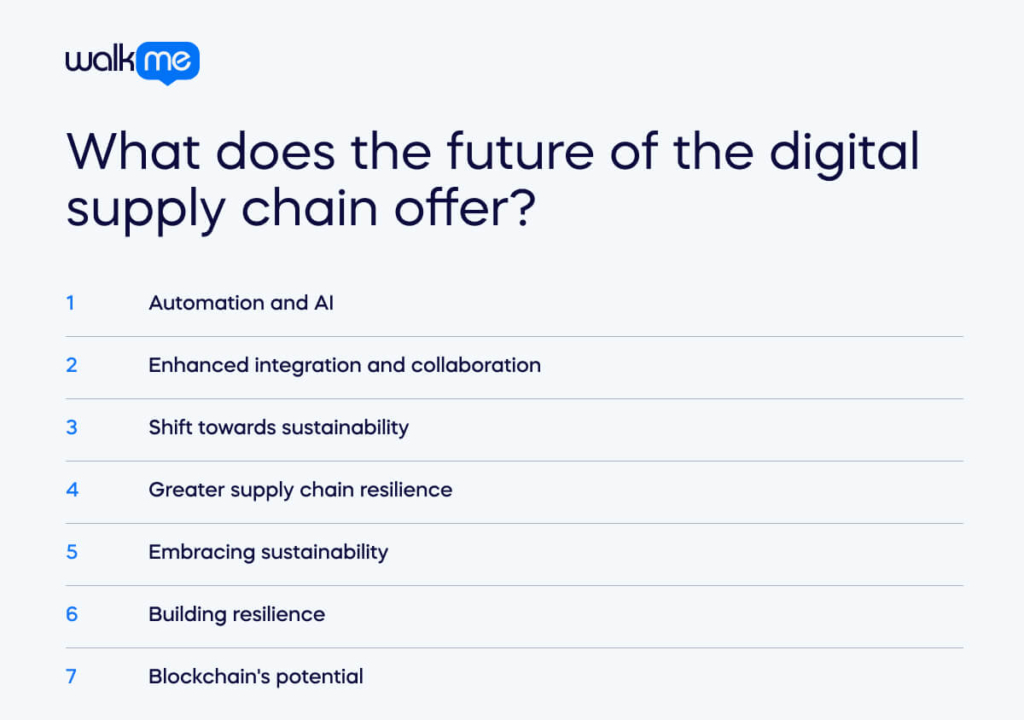
Digital transformation in the supply chain is exciting but challenging as customers constantly want more significant, better, more cutting-edge experiences. These desires require constant technological updates, and the best way to ensure you fulfill the needs of customers and your organization is to look to future technologies. The first of these is automation and AI.
Automation and AI
Digital supply chains will witness a surge in automation and AI alongside AI adoption challenges. Robots and automated systems will streamline warehouse management, order fulfillment, and transportation tasks. AI-powered algorithms will optimize processes, predict demand fluctuations, and monitor emissions.
Examples include your program’s participants: Singular Intelligence using AI to track supply-demand imbalances in Sainsbury’s meat supply chain and Versed AI leveraging AI for risk identification and improved decision-making.
Enhanced integration and collaboration
Silos will crumble as digitalization fosters closer collaboration throughout the supply chain. Shared platforms, standardized protocols, and secure data exchange will be instrumental in this shift. Infoculture’s project within your program exemplifies this, aiming to facilitate seamless information flow and enhanced collaboration among supply chain partners.
Shift towards sustainability
Sustainability will become a central tenet of digital supply chains. Eco-friendly technologies and practices will be standard, and organizations will integrate sustainability metrics into operations. Initiatives like Data Catalyst’s project to capture data on Scope 3 emissions for manufacturers represent this growing focus.
Greater supply chain resilience
Building resilience to handle routine and catastrophic disruptions will be paramount. Blockchain technology, despite recent setbacks, holds immense potential. By 2025, we can expect wider digital adoption for tasks like tracking and tracing, contract management, and supply chain finance.
Embracing sustainability
Environmental responsibility is taking center stage within digital supply chains. Beyond mere compliance, organizations are actively adopting eco-friendly technologies and practices.
This step includes integrating sustainability metrics into core operations, such as capturing Scope 3 emissions data to inform reduction strategies. Projects like Data Catalyst’s manufacturer emission-tracking initiative exemplify this proactive approach.
Building resilience
Adapting to unforeseen risks, from daily operational hiccups to significant disruptions, is crucial for supply chain success. Resilience demands both proactive planning and agile responsiveness. Organizations can navigate challenges effectively by anticipating diverse threats and implementing robust contingencies.
Blockchain’s potential
Despite recent setbacks like TradeLens’ closure, blockchain technology holds immense promise for enhancing supply chain security and transparency.
By 2025, we can expect wider adoption for tasks like:
- Enhanced tracking and tracing: Providing end-to-end product movement and origin visibility, promoting ethical sourcing, and preventing counterfeiting.
- Streamlined contract management: Automating and securing contractual agreements, improving efficiency, and reducing disputes.
- Innovative supply chain finance: Facilitating secure and transparent financial transactions among supply chain partners, boosting trust and efficiency.
These emerging trends, driven by digitalization, showcase a future where sustainability, resilience, and blockchain innovation work together to create robust and responsible supply chains for the years to come.
The Imperative Role of Digital Transformation in Supply Chain Dynamics
In supply chain dynamics, digital transformation is imperative for organizational success, epitomizing a paradigm shift towards heightened agility, efficiency, and responsiveness.
The significance lies in its transformative ability to empower businesses in navigating the intricate modern markets. Embracing digital technologies equips organizations with the tools needed to seamlessly adapt to the ever-evolving demands of consumers and the fluctuating dynamics of the global economy.
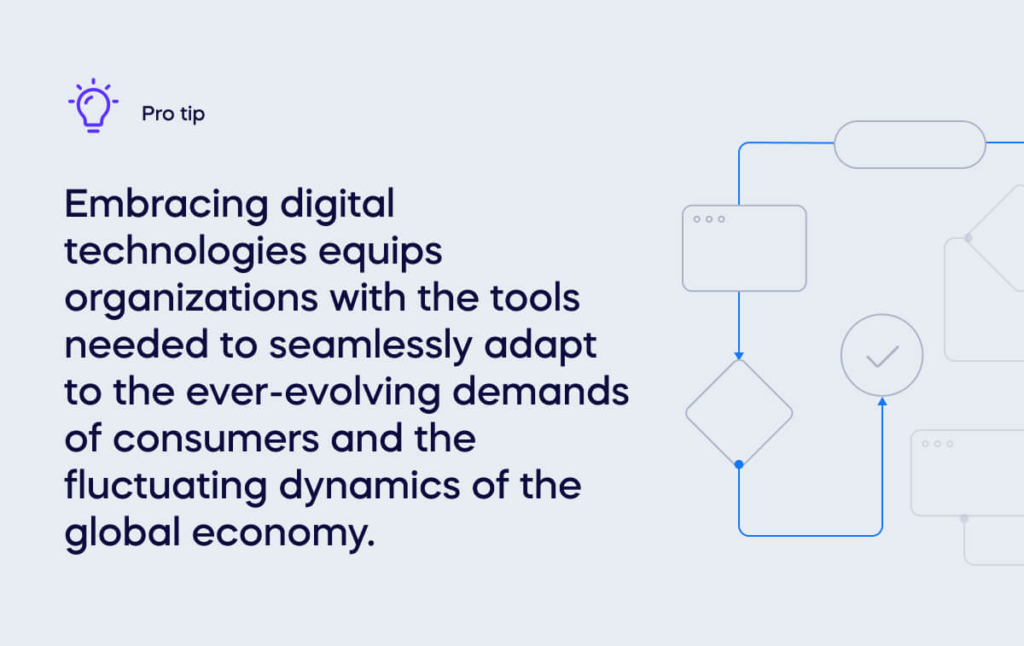
At its core, supply chain digital transformation enables a streamlined and interconnected approach, fostering operational optimization. The accelerated pace of technological integration facilitates real-time data analysis, enhancing decision-making processes. This mitigates risks and enables businesses to proactively respond to emerging challenges, ensuring a robust and resilient supply chain ecosystem.
Furthermore, the customer-centric focus inherent in digital transformation ensures that businesses are not just reactive but anticipatory in their strategies. Organizations can proactively align their supply chain processes with shifting consumer behaviors by harnessing the power of advanced analytics, artificial intelligence, and automation.
Ultimately, the success of supply chain digital transformation lies in its capacity to future-proof businesses, positioning them at the forefront of innovation and adaptability in an ever-changing marketplace.

